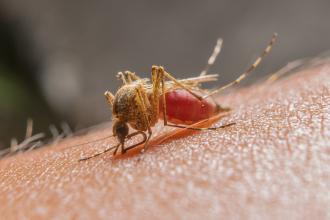West Nile virus update
West Nile virus (WNV) continued its westward spread across North America in 2003, but did not enter British Columbia. The risk that the virus will move into BC during 2004 remains high. There is also a risk that BC residents will become infected while traveling outside the province. The following is an update on WNV based on findings from the past year.
WNV geographic spread in 2003
In Canada, WNV activity was intense in the southern prairies during 2003, and the virus reached the Rocky Mountain foothills. Alberta, Saskatchewan, Manitoba, Ontario, New Brunswick, and Nova Scotia have now had endemic or enzootic WNV transmission. In continental US, 46 of 48 states experienced activity in 2003, and the virus spread beyond the Rocky Mountains to reach southern California. Only BC, Washington, Oregon, PEI, and Newfoundland did not have WNV activity in 2003.
WNV and birds
WNV is primarily an avian virus spread by bird-biting mosquitoes. The virus has been detected in more than 225 bird species. With few exceptions, most bird species survive WNV infection. Corvids (crow family) have a high fatality rate, and testing of dead crows helps determine when WNV is active in an area. Last year 1907 corvids were tested for WNV from throughout BC and all were negative.
WNV and mosquitoes
To date, WNV has been detected in 49 species of mosquitoes in North America. Culex pipiens (the northern house mosquito) is the main vector species in eastern North America, while C. tarsalis is the main vector in the prairies. Both species are established in BC.[1] More than 6700 mosquitoes were tested for WNV in BC during 2003, and all were negative.
WNV infections in humans
During 2003, there were 1335 cases reported in Canada and 9858 in the US. The majority of reported illnesses were West Nile fever, a dengue-like illness that may present with fever, headache, fatigue, myalgia, arthalgia, lymphadenopathy, and maculopapular rash. The virus can also infect various levels of the nervous system (West Nile neurological syndrome or WNNS), with clinical presentations that may include meningitis, encephalitis, polio-like paralysis, movement disorders, and parkinsonism. During 2003, 160 (12%) of reported cases in Canada and 2863 (29%) of cases in the US presented with WNNS.
WNV diagnostic tests
Diagnostic tests should be ordered on patients with clinical presentations consistent with WNV infection, including WNV fever or WNNS, during the period when WNV could be transmitted by mosquitoes in BC (spring until the first hard frost in autumn). Appropriate specimens include:
• Acute serum collected on presentation and convalescent serum collected 14 days to 21 days later. Serum (7 mL to 10 mL) should be collected in a pink-top tube and sent to BCCDC Laboratory Services.
• Acute plasma collected on presentation. Plasma (7 mL to 10 mL) should be collected in a purple-top tube and sent to BCCDC Laboratory Services.
• Cerebrospinal fluid (CSF): 1 cc to 2 cc should be collected in each of two tubes without any preservatives. It should be kept at 4°C or frozen for transport to the BCCDC laboratory.
Include the patient’s onset date on the laboratory requisition. Other agents, including herpes simplex, should be considered in the differential diagnosis for encephalitis and appropriate diagnostic tests ordered.
WNV therapy and vaccine
At present, no known effective antiviral therapy exists, although ribavirin and interferon-beta are being tried experimentally. Work continues on the development of a chimeric vaccine for humans, but none is currently available.
WNV and pregnancy
The consequences of WNV infection during pregnancy have not been well defined. The US CDC is gathering data on pregnancy outcomes for 70 women with WNV illness during pregnancy[2] and further information may become available during 2004.
WNV and blood
WNV can be transmitted through blood or organ transplantation. Please refer to the related paper by Dr Bigham on page 220 of this issue of the BCMJ.
Reportability in BC
Physicians must report the following to the medical health officer in their area:
• Patients who have lab-confirmed WNV fever or WNNS.
• Patients who have a clinical presentation consistent with WNNS during a period of time (spring until hard frost in autumn) when mosquitoes may transmit WNV.
Prevention
Patients should be reminded of measures to prevent mosquito bites, including wearing long, light-colored clothing, and using insect repellents with DEET.
—Murray Fyfe MD, FRCPCC
—Muhammad Morshed, PhD, SCCM
BC Centre for Disease Control
References
1. Belton P. The mosquitoes of British Columbia. Victoria, BC: Handbook (British Columbia Provincial Museum) No. 41, 1983. 189 pp.
2. Centers for Disease Control and Prevention (CDC). Interim guidelines for the evaluation of infants born to mothers infected with West Nile virus during pregnancy. Morb Mortal Wkly Rep 2004;53:154-157. PubMed Abstract Full Text

